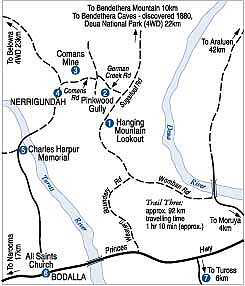 Last Sunday we went on a drive south
to the little town of Bodalla - see map reference 6 - and into the hinterland and, on the spur of the moment, decided to drive out to the small
town of Nerrigundah - or rather, what's left of it. The Nerrigundah Mountain Road heads west out of Eurobodalla and becomes unsealed after about
6 km, crossing the picturesque Tuross River at a place which commemorates Charles Harpur, one of Australia's earliest bush poets who had a farm near
Nerrigundah in the 1860s - see map reference 5.
Last Sunday we went on a drive south
to the little town of Bodalla - see map reference 6 - and into the hinterland and, on the spur of the moment, decided to drive out to the small
town of Nerrigundah - or rather, what's left of it. The Nerrigundah Mountain Road heads west out of Eurobodalla and becomes unsealed after about
6 km, crossing the picturesque Tuross River at a place which commemorates Charles Harpur, one of Australia's earliest bush poets who had a farm near
Nerrigundah in the 1860s - see map reference 5. 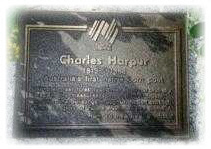 Driving along, we thought we could see a caravan park - a
caravan park in this remote spot, we wondered? -; on getting closer we discovered that it was a chicken farm whose owner was using half-a-dozen old
caravans to house his chickens! It certainly puts a new meaning on the words "Free Range Eggs"!
Driving along, we thought we could see a caravan park - a
caravan park in this remote spot, we wondered? -; on getting closer we discovered that it was a chicken farm whose owner was using half-a-dozen old
caravans to house his chickens! It certainly puts a new meaning on the words "Free Range Eggs"!
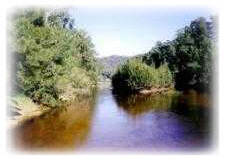 Leaving the pretty river behind us, we followed a dry
and dusty road until we entered the green valley in which Nerrigundah is nestled, surrounded by rugged mountain wilderness. Nerrigundah, an Aboriginal
word meaning "Place of Many Berries", is now a peaceful village, and it is difficult to imagine in this tranquillity that once men toiled, sweated and
killed here for gold...
Leaving the pretty river behind us, we followed a dry
and dusty road until we entered the green valley in which Nerrigundah is nestled, surrounded by rugged mountain wilderness. Nerrigundah, an Aboriginal
word meaning "Place of Many Berries", is now a peaceful village, and it is difficult to imagine in this tranquillity that once men toiled, sweated and
killed here for gold...
After a gold strike at nearby Mt Dromedary in 1860 prospectors found gold at Gulph Creek precipitating a rush at Nerrigundah in 1861. Amenities, and dredges, began to appear and the town was surveyed in 1867. At its height the site was alleged to have 2000 to 3000 inhabitants, including many Chinese, who had at their disposal five hotels and several shops, including one for the Chinese residents, as well as a police station and courthouse. A bit hard to believe today! The mine - see map reference 3 - was opened in the 1880s by EJ Coman and his partner Bloomfield. It operated for a brief but unsuccessful period and by 1889 was left idle and the population began to dwindle.
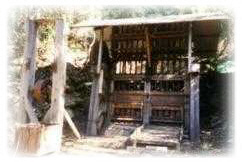 The mine may have been worked periodically since but
it wasn't reopened until 1938 by Radiant Mines. It was last worked by Immarna Mines from 1947 to 1950, but there is some anecdotal evidence to
suggest that the hunt for gold may have continued through to the 1960s. Today, a walking trail passes by relics of the mine, including the stamper
battery used to crush ore and the railway tracks used to move ore from the shafts.
The mine may have been worked periodically since but
it wasn't reopened until 1938 by Radiant Mines. It was last worked by Immarna Mines from 1947 to 1950, but there is some anecdotal evidence to
suggest that the hunt for gold may have continued through to the 1960s. Today, a walking trail passes by relics of the mine, including the stamper
battery used to crush ore and the railway tracks used to move ore from the shafts.
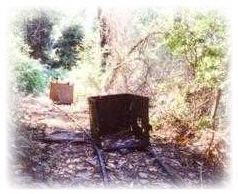
Sawmilling saw a faint revival of the village in
the 1950s but little remains today except a few houses and a large monument
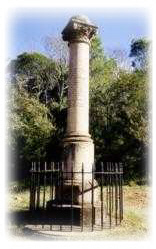 associated with the
Clarke Brothers
bushranging gang. On Sunday, April 8, 1866 the gang took over a hut beside Deep Creek, just south of Nerrigundah, and held up the passers by.
Among them was Moruyah storekeeper, John Emmott, who was riding home with his dealings. The gang shot his horse from under him, robbed him of
the small fortune in his possession, shot him in the thigh and hit him on the head with a pistol. Not satisfied with their gains and perhaps
fueled by the ease of their pickings five of the gang rode into Nerrigundah and held up the diggers at the hotel. Two more entered Pollock's
Store, now a museum with local information. The owner, one of the main gold purchasers, was forced to furnish the key to his safe. However,
while the gang were herding more of victims into the hotel Mrs Pollock snatched the safe key from Thomas Clarke and threw it across the street,
where one of her children clinched it between his toes and walked off with it. A candlelight search in the gloam by Clarke proved fruitless.
associated with the
Clarke Brothers
bushranging gang. On Sunday, April 8, 1866 the gang took over a hut beside Deep Creek, just south of Nerrigundah, and held up the passers by.
Among them was Moruyah storekeeper, John Emmott, who was riding home with his dealings. The gang shot his horse from under him, robbed him of
the small fortune in his possession, shot him in the thigh and hit him on the head with a pistol. Not satisfied with their gains and perhaps
fueled by the ease of their pickings five of the gang rode into Nerrigundah and held up the diggers at the hotel. Two more entered Pollock's
Store, now a museum with local information. The owner, one of the main gold purchasers, was forced to furnish the key to his safe. However,
while the gang were herding more of victims into the hotel Mrs Pollock snatched the safe key from Thomas Clarke and threw it across the street,
where one of her children clinched it between his toes and walked off with it. A candlelight search in the gloam by Clarke proved fruitless.
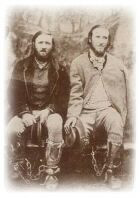
Trooper Miles O'Grady and another trooper entered the hotel just as two of the gang were threatening to kill local butcher, Robert Drew, who had thrown a roll of notes over their heads behind the bar. O'Grady fired at the two men, narrowly missing Patrick O'Connell but killing William Fletcher, a young jockey and son of a prosperous Batemans Bay farmer, who had only joined the gang the previous day. O'Grady was then shot through the heart in the return fire from William Clarke. The gang then fled town, picked up the other gang members from their base on Deep Creek and journeyed north.
Sergeant Hitch, the officer in charge of the Nerrigundah police returned from Moruya and organised a twelve-man posse. They ambushed the gang at Eucumbene River but no-one was captured, the only victim being a pack horse laden with goods from the store. They were officially declared outlaws the following month.
The monument in town is in honour of O'Grady who was buried in Moruya cemetery. However, it is incorrect that he fought the gang single-handedly as the monument claims. Fletcher's grave, which was allegedly wrapped in bark, was laid and can still be found outside of the Nerrigundah cemetery, about 25 metres from the back right-hand corner. The cemetery itself is behind a grove of wattle trees a hundred metres beyond the monument and slightly to its right.
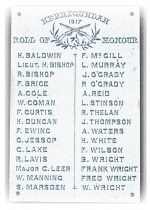 Nerrigundah was still a
bustling little town at the outbreak of World War I which many of its men joined up for. A "Roll of Honour" of those fallen in that
war lists descendants of the miners and Trooper Miles O'Grady.
Nerrigundah was still a
bustling little town at the outbreak of World War I which many of its men joined up for. A "Roll of Honour" of those fallen in that
war lists descendants of the miners and Trooper Miles O'Grady.
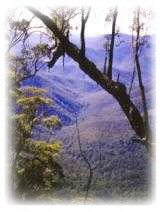 Today Nerrigundah and the surrounding valley
is inhabited by just a handful of people who came in search of some cheap rural acreage and now appreciate being in this very peaceful place -
as so aptly described by one of its inhabitants, an Anthony Harris, in
this article, when he writes
that "although I travel around Australia, I love to get back, and feel the difference of being in my special place" and about "the
soft and vibrant colours of the bush, and the sense of mystery and aliveness it holds."
Today Nerrigundah and the surrounding valley
is inhabited by just a handful of people who came in search of some cheap rural acreage and now appreciate being in this very peaceful place -
as so aptly described by one of its inhabitants, an Anthony Harris, in
this article, when he writes
that "although I travel around Australia, I love to get back, and feel the difference of being in my special place" and about "the
soft and vibrant colours of the bush, and the sense of mystery and aliveness it holds."
We drove little more than a hundred kilometres on this short trip, and yet we saw so much and gained so many new impressions. It seems to prove what Goethe said in his "Erinnerung": Warum in die Ferne schweifen, wenn das Gute liegt so nah? Willst du immer weiter schweifen? Sieh, das Gute liegt so nah. Lerne nur das Glück ergreifen. Denn das Glück ist immer da.
Best wishes and
from us all!
Peter & Padma & Malty & Rover
& Rover
riverbend@batemansbay.com
10 October 2005